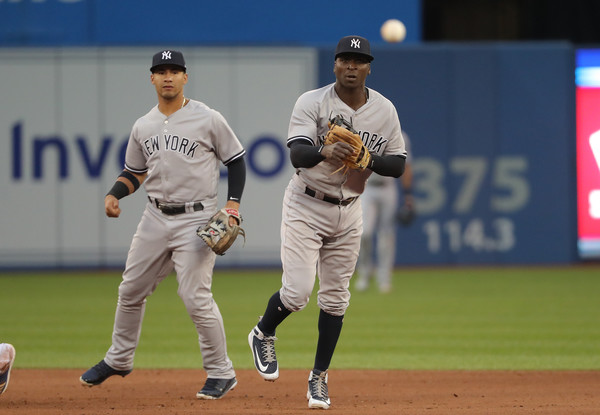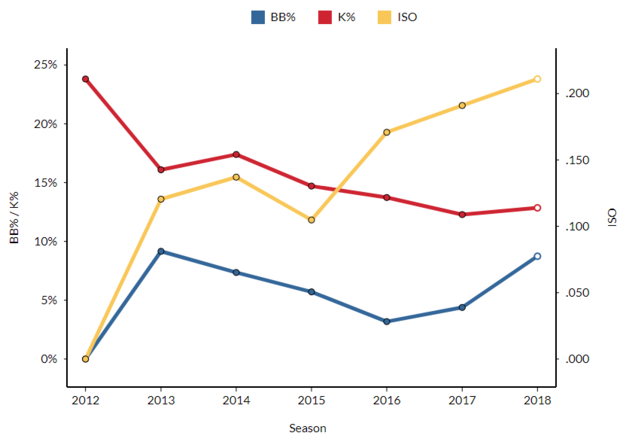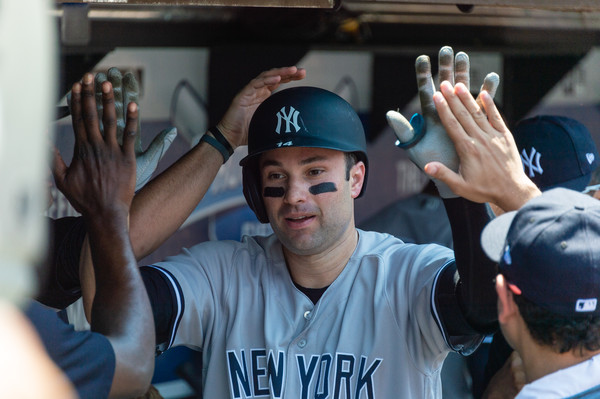
A large portion of the Yankees off-season was spent worrying about who would be manning the keystone and the hot corner. There was buzz, of course, that Gleyber Torres and Miguel Andujar would be given the keys eventually – but it seemed unlikely (at best) that the organization would be starting two rookies on Opening Day. It wasn’t until late-February that they added a legitimate veteran option to the mix in Brandon Drury, and three weeks later Neil Walker was signed; and the short-term fates of Torres and Andujar felt sealed.
Of course, nothing ever quite goes according to plan.
Miguel Andujar
Midseason Grade: B
It feels a bit strange to hang a ‘B’ on a 23-year-old rookie that finished the first-half slashing .279/.316/.489 (116 wRC+) with a rookie-best 41 extra-base hits, but here we are. And so I’ll start with the negative:
Andujar is a bad defensive third baseman.
Defensive metrics are notoriously fickle, particularly when small sample sizes are at issue, but Andujar ranks dead last among third basemen in DRS (-12) and UZR (-6.8), second to last in Total Zone, and third to last in FRAA. He’s sure-handed, as evidenced by his ranking 8th in converting routine plays at the position per Inside Edge fielding data – but he’s third to last in ‘likely’ plays, and last in plays with ‘even’ odds. And that matches the eye test.
Offensively, however, Andujar has been quite good. The 4.7% walk rate is disconcerting, but he makes plenty of contact (17.4% strikeout rate), hits the ball hard (90.1 MPH exit velocity against a league-average of 88.6), and hits for power (.210 ISO). And he’s already shown a penchant for heroics:
Greg Bird
Midseason Grade: C
I was tempted to give Bird an incomplete, as he spent all of April and most of May on the disabled list. But he has been a fixture in the lineup since coming back for good on May 26, and he’s healthy and hitting right now. And, with the All-Star break upon us, we now have three relatively equal sample sizes of Bird’s performance to look at – and the similarities of his three partial seasons may surprise you:

Bird’s walk percentage, strikeout rate, and isolated power are all within spitting distance on a year-to-year basis, so the shape of his production is something of a known commodity. The greatest outlier here seems to be rooted in his BABIP, which is all over the place – and for good reason, as his batted ball profile has varied dramatically:

There are three tremendous differences to be noted here (two of which are dependent upon each other): his grounders, his flyballs, and his pull percentage. Bird’s putting the ball on the ground way more, which naturally means that he’s getting the ball into the air less often, and he’s pulling the majority of his batted balls to the right side of the field. And, given that he hits against the shift quite often, that’s why he’s batting .059 on grounders … against a league-average of around .240. Some of that is undoubtedly luck, as well, but a lead-footed slugger pulling lots of balls into the teeth of the defense isn’t a great means to an end. Though, to be fair, his groundball percentage is lower than league-average – it’s simply higher than it should be for a hitter of his ilk (and trending in the wrong direction).
On the plus side, Bird’s quality of contact is quite good. His soft-hit percentage is nearly eight percentage points better than average, and that difference is split between medium and hard contact, both of which are around four percentage points above-average. Put that all together, and his average exit velocity is 88.5 MPH, which is … well … average.
All told, Bird is batting .214/.317/.457, which is good for a 109 wRC+. That puts him right in-line with the league-average first baseman, who’s batting .249/.331/.438 (108 wRC+). nd he posted a .281/.359/.625 slash line in his last nine games of the first-half, which works out to an average grade for me.
Didi Gregorius
Midseason Grade: A
I am not sure that I have ever seen any one player be as good as Gregorius was in March/April and as bad as he was in May in the course of one season, let alone back-to-back months. Take a look for yourself:
- March/April: .327/.421/.735, 24 R, 10 HR, 30 RBI, 18 BB, 200 wRC+
- May: .149/.184/.213, 9 R, 1 HR, 5 RBI, 4 BB, -1 wRC+
From a broader perspective, Gregorius was the third-best hitter in baseball in March/April (by wRC+), just behind Mookie Betts (210 wRC+) and Manny Machado (201). He followed that up by ranking dead last among 173 qualified hitters in May. That’s nothing short of impressive. Gregorius has righted the ship, though, and is hitting .292/.341/.468 (119 wRC+) since the calendar flipped to June. And he finished the half slashing .263/.326/.474 (114 wRC+) with 17 HR and a career-high 10 SB. He also continued his ownership of Corey Kluber in the final series of the half:

All of those lines are trending in the right direction, and work together to give us the best version of Gregorius to-date. It is interesting to note that he did walk at an above-average rate way back in 2013 with the Diamondbacks, and then developed an itchier trigger finger over time. Perhaps this is simply his final form.
Gleyber Torres
Midseason Grade: A+
Were you expecting something else?
Torres hit the DL with a hip injury on the Fourth of July, but that has been the only aspect of his season to-date that has even the slightest tinge of disappointment. The 21-year-old is slashing .294/.350/.555 (143 wRC+) with 15 HR, and he has already shown a flair for the dramatic multiple times over. In True Yankee™ fashion, Torres hit a walk-off home run against the Indians in his fifteenth big league game:
What otherwise stands out the most about his season thus far is his power. Those 15 bombs have come in 241 PA – or one every 16.1 PA. Torres hit 24 HR in the minors, across 1591 PA … or once every 66.3 PA. It isn’t uncommon for a player to develop more power over time, and the majority of his time in the minors was spent in pitcher’s parks – but most scouting reports saw him as a guy that could hit 15 to 20 home runs in a season. At his current pace, he would hit 40 home runs in a 650 PA season. That’s quite the difference.
On the off-chance that you want some cold water thrown on you, consider his plate discipline rates:

The top row represents Torres, and the bottom is league-average. The short version: Torres swings more often at pitches in and out of the zone, and makes less contact than the average batter on pitches in and out of the zone. It is worth noting, however, that his swing percentage on pitches outside of the zone has been declining at a slow-and-steady pace.
Defense has been a mixed bag for Torres, as well – but it’s kind of difficult for me to make much out of that. Heading into 2018, Torres had played just 18 games at second base, so he is essentially learning the position on the fly. Moreover, unlike Andujar, Torres has long drawn strong marks for his defense, with most believing that he could stick at shortstop long-term. And, also unlike Andujar, Torres’s defensive metrics are all over the place. DRS has him as a +2 defender, whereas UZR has him at -4.3. I’m confident that his defense isn’t a concern.
Neil Walker

Midseason Grade: F
I wanted to be cheeky and go with an F+ or a D-, but I simply couldn’t justify it. Walker is hitting .197/.278/.285, which translates to a 55 wRC+ … which ranks 248th among 258 hitters with at least 200 PA. And his -0.7 WAR is even worse, ranking 253rd among that same group of players. Saying that Walker has been bad is an understatement.
As there’s no real arguing that Walker has been anything less than awful, let’s just dig into some of the few good things about his 2018. There was this walk-off:
It seems likely that Walker would have been gone already if the Yankees didn’t have Bird, Drury, and Torres go down with injuries at different times, doesn’t it? And that means his time in pinstripes may be running out as Torres is slated to return shortly.
Leave a Reply
You must be logged in to post a comment.